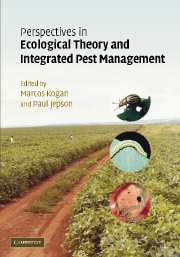Book contents
- Frontmatter
- Contents
- List of Contributors
- Preface
- 1 Ecology, sustainable development, and IPM: the human factor
- 2 From simple IPM to the management of agroecosystems
- 3 Populations, metapopulations: elementary units of IPM systems
- 4 Arthropod pest behavior and IPM
- 5 Using pheromones to disrupt mating of moth pests
- 6 Nutritional ecology of plant feeding arthropods and IPM
- 7 Conservation, biodiversity, and integrated pest management
- 8 Ecological risks of biological control agents: impacts on IPM
- 9 Ecology of natural enemies and genetically engineered host plants
- 10 Modeling the dynamics of tritrophic population interactions
- 11 Weed ecology, habitat management, and IPM
- 12 The ecology of vertebrate pests and integrated pest management (IPM)
- 13 Ecosystems: concepts, analyses, and practical implications in IPM
- 14 Agroecology: contributions towards a renewed ecological foundation for pest management
- 15 Applications of molecular ecology to IPM: what impact?
- 16 Ecotoxicology: The ecology of interactions between pesticides and non-target organisms
- Index
- References
13 - Ecosystems: concepts, analyses, and practical implications in IPM
Published online by Cambridge University Press: 04 August 2010
- Frontmatter
- Contents
- List of Contributors
- Preface
- 1 Ecology, sustainable development, and IPM: the human factor
- 2 From simple IPM to the management of agroecosystems
- 3 Populations, metapopulations: elementary units of IPM systems
- 4 Arthropod pest behavior and IPM
- 5 Using pheromones to disrupt mating of moth pests
- 6 Nutritional ecology of plant feeding arthropods and IPM
- 7 Conservation, biodiversity, and integrated pest management
- 8 Ecological risks of biological control agents: impacts on IPM
- 9 Ecology of natural enemies and genetically engineered host plants
- 10 Modeling the dynamics of tritrophic population interactions
- 11 Weed ecology, habitat management, and IPM
- 12 The ecology of vertebrate pests and integrated pest management (IPM)
- 13 Ecosystems: concepts, analyses, and practical implications in IPM
- 14 Agroecology: contributions towards a renewed ecological foundation for pest management
- 15 Applications of molecular ecology to IPM: what impact?
- 16 Ecotoxicology: The ecology of interactions between pesticides and non-target organisms
- Index
- References
Summary
Introduction
A major principle of integrated pest management (IPM) is that strategies and tactics be consistent with ecological processes. IPM advanced traditional pest control by recognizing economic thresholds (below which population size does not warrant suppression), and addressing aspects of herbivore–plant and predator–prey interactions amenable to manipulation for pest control purposes. However, the premise that herbivorous insects and pathogens in general are detrimental to plant growth and reproduction has persisted.
In recent years, our perspective of insect herbivores has begun to change from this traditional view to a view that recognizes the role of native insect herbivores in maintaining plant productivity, vegetative diversity, and other ecosystem properties at ecosystem carrying capacity. Recent advances in studies of integrated ecosystems has led to an emerging view of herbivores as a negative feedback (regulatory) mechanism, triggered by environmental changes, that may stabilize ecosystem structure and function in natural ecosystems.
Commodity systems are maintained intentionally in an artificial condition to maximize commodity production, generally on an annual basis. This triggers herbivore responses to resource quality or abundance that may be undesirable for some management goals. Nevertheless, understanding the factors that trigger herbivore outbreaks and their consequences for ecosystems conditions can lead to improved management decisions, particularly strategies for preventing outbreaks and methods for evaluating the need for pest suppression, consistent with the objective that IPM supports ecological principles. IPM tactics will still be necessary, especially in the artificial environment of crop systems, or for managing exotic pests.
Information
- Type
- Chapter
- Information
- Perspectives in Ecological Theory and Integrated Pest Management , pp. 411 - 430Publisher: Cambridge University PressPrint publication year: 2007
References
Accessibility standard: Unknown
Why this information is here
This section outlines the accessibility features of this content - including support for screen readers, full keyboard navigation and high-contrast display options. This may not be relevant for you.Accessibility Information
- 1
- Cited by
